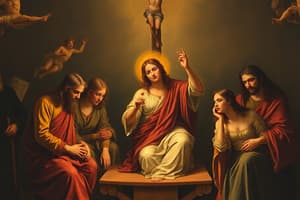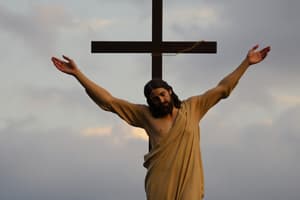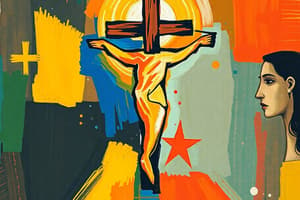Podcast
Questions and Answers
Gnostics believed that salvation for humanity was accomplished by tangible rituals and is available to many.
Gnostics believed that salvation for humanity was accomplished by tangible rituals and is available to many.
False (B)
Eutyches of Constantinople is known for initiating the Monophysite heresy.
Eutyches of Constantinople is known for initiating the Monophysite heresy.
True (A)
St. Cyril of Alexandria was the principal opponent of Arius who promoted Arianism.
St. Cyril of Alexandria was the principal opponent of Arius who promoted Arianism.
False (B)
The Council of Chalcedon taught that the divine and human natures of Christ are united with change.
The Council of Chalcedon taught that the divine and human natures of Christ are united with change.
According to Catholic teaching, Jesus Christ is considered a divine person.
According to Catholic teaching, Jesus Christ is considered a divine person.
Karl Barth believed that the restoration of the covenant was related to original sin.
Karl Barth believed that the restoration of the covenant was related to original sin.
The council of Nicaea took place in 400 AD.
The council of Nicaea took place in 400 AD.
The term 'hypostatic union' refers to the union of the divine and human nature in the one divine person of Jesus Christ.
The term 'hypostatic union' refers to the union of the divine and human nature in the one divine person of Jesus Christ.
Nestorius believed that Jesus was 100% divine and 0% human.
Nestorius believed that Jesus was 100% divine and 0% human.
The image of the Sacred Heart is central to Catholic devotion as it reflects both the humanity and divinity of Christ.
The image of the Sacred Heart is central to Catholic devotion as it reflects both the humanity and divinity of Christ.
What did the Ebionites deny regarding Jesus Christ?
What did the Ebionites deny regarding Jesus Christ?
According to Gnostic beliefs, how is salvation achieved?
According to Gnostic beliefs, how is salvation achieved?
What was Arius' main concern regarding the nature of the Son of God?
What was Arius' main concern regarding the nature of the Son of God?
What significant claim did Nestorius make about Mary?
What significant claim did Nestorius make about Mary?
What do the terms 'Homousios' and 'Monogeneis' refer to?
What do the terms 'Homousios' and 'Monogeneis' refer to?
Which council condemned Nestorianism?
Which council condemned Nestorianism?
What is the Monophysite belief about the nature of Christ after the Incarnation?
What is the Monophysite belief about the nature of Christ after the Incarnation?
What significant teaching did the Council of Chalcedon affirm regarding Christ's natures?
What significant teaching did the Council of Chalcedon affirm regarding Christ's natures?
The principal opponent of Arius was known to be who?
The principal opponent of Arius was known to be who?
Which council condemned the practice of Iconoclasm?
Which council condemned the practice of Iconoclasm?
What did the term 'Theotokos' mean in relation to Mary?
What did the term 'Theotokos' mean in relation to Mary?
What does the hypostatic union describe?
What does the hypostatic union describe?
Which council addressed the controversy surrounding Arianism?
Which council addressed the controversy surrounding Arianism?
Who is regarded as the saint that Jesus appeared to revealing the Sacred Heart?
Who is regarded as the saint that Jesus appeared to revealing the Sacred Heart?
What principal theme is associated with John Paul II's Christology?
What principal theme is associated with John Paul II's Christology?
What did Nestorius believe about the nature of Jesus?
What did Nestorius believe about the nature of Jesus?
Which heresy does not allow for the making of images of Christ?
Which heresy does not allow for the making of images of Christ?
What was Karl Barth's view on original sin?
What was Karl Barth's view on original sin?
What is the date when the Council of Constantinople condemned Apollinarius?
What is the date when the Council of Constantinople condemned Apollinarius?
What role did Jesus serve as Christ the Priest?
What role did Jesus serve as Christ the Priest?
What is the foundational belief of the Gnostics regarding salvation?
What is the foundational belief of the Gnostics regarding salvation?
Which theological term means 'consubstantial' and describes the relationship between the Father and the Son?
Which theological term means 'consubstantial' and describes the relationship between the Father and the Son?
What was the primary assertion made by the Monophysites regarding Christ's nature post-incarnation?
What was the primary assertion made by the Monophysites regarding Christ's nature post-incarnation?
Which statement best summarizes Nestorius' teaching about Mary?
Which statement best summarizes Nestorius' teaching about Mary?
Which council condemned the teachings of Apollinarius regarding Christ?
Which council condemned the teachings of Apollinarius regarding Christ?
Flashcards
Homousios
Homousios
Consubstantial; of the same nature. Describes the relationship between the Father and Son in the Trinity—they are of the same divine nature.
Monophysite
Monophysite
Belief that Christ had only one nature after the Incarnation; the human nature was absorbed into the divine.
Theotokos
Theotokos
A Greek title meaning 'God-bearer' or 'Mother of God'. Refers to Mary, the mother of Jesus.
Iconoclasm
Iconoclasm
Signup and view all the flashcards
Nestorianism
Nestorianism
Signup and view all the flashcards
Hypostatic Union
Hypostatic Union
Signup and view all the flashcards
Council of Nicaea
Council of Nicaea
Signup and view all the flashcards
Original Sin, Karl Barth's View
Original Sin, Karl Barth's View
Signup and view all the flashcards
Who taught Bonaventure 'everything'?
Who taught Bonaventure 'everything'?
Signup and view all the flashcards
What does the Sacred Heart image symbolize?
What does the Sacred Heart image symbolize?
Signup and view all the flashcards
What is the foundation of Vatican II's Christology?
What is the foundation of Vatican II's Christology?
Signup and view all the flashcards
What is Christ's role as Priest?
What is Christ's role as Priest?
Signup and view all the flashcards
What is Christ's role as King?
What is Christ's role as King?
Signup and view all the flashcards
What is the main theme of John Paul II's Christology?
What is the main theme of John Paul II's Christology?
Signup and view all the flashcards
What did the Docetists deny?
What did the Docetists deny?
Signup and view all the flashcards
What was Arius' Trinitarian concern?
What was Arius' Trinitarian concern?
Signup and view all the flashcards
What did the Council of Nicaea address?
What did the Council of Nicaea address?
Signup and view all the flashcards
What does Theotokos mean?
What does Theotokos mean?
Signup and view all the flashcards
Ontological Christology
Ontological Christology
Signup and view all the flashcards
Functional Christology
Functional Christology
Signup and view all the flashcards
What did the Ebionites deny?
What did the Ebionites deny?
Signup and view all the flashcards
What did the Arians believe about Christ?
What did the Arians believe about Christ?
Signup and view all the flashcards
What did the Gnostics believe about salvation?
What did the Gnostics believe about salvation?
Signup and view all the flashcards
What did the Docetists believe about the incarnation?
What did the Docetists believe about the incarnation?
Signup and view all the flashcards
What did Apollinarius believe about Jesus' humanity?
What did Apollinarius believe about Jesus' humanity?
Signup and view all the flashcards
What did Nestorius believe about Mary's role?
What did Nestorius believe about Mary's role?
Signup and view all the flashcards
What is Monophysitism?
What is Monophysitism?
Signup and view all the flashcards
What did the Council of Chalcedon declare about Christ's natures?
What did the Council of Chalcedon declare about Christ's natures?
Signup and view all the flashcards
Ebionites
Ebionites
Signup and view all the flashcards
Gnostics
Gnostics
Signup and view all the flashcards
Arius
Arius
Signup and view all the flashcards
Study Notes
Christological Studies
- Ontological Christology: Focuses on the identity of Christ.
- Functional Christology: Focuses on the mission of Christ as savior.
Heresies and Early Christological Debates
- Ebionites: Denied the divinity of Christ, viewed him as one of Israel's prophets.
- Gnostics: Believed salvation was accomplished through secret knowledge, achieved by a select few. Classified people into three groups: Hylics (ruled by desires of flesh), Psychics (ruled by the mind), and Pneumatics (ruled by the spirit). Their view of the material world influenced Docetists, who denied Christ's humanity, as they viewed the material and human body as evil.
- Docetists: Denied the humanity of Christ.
- Arius: Questioned Christ's equality with God, arguing that if Christ was fully divine and fully human, God would have changed—something impossible. Arius' Trinitarian concern was that the Son is not equal in divinity to God, because if they are equal, there is a division and there is no god.
- Arian Controversy: Addressed by the Council of Nicaea (325 AD).
- St. Athanasius: Principal opponent of Arius.
- Council of Nicaea (325 AD): Defined key theological terms:
- Homousios: Consubstantial, of the same nature. Father and Son are God.
- Monogeneis: Only begotten.
- Apollinarius: Taught that Jesus lacked a human soul. Condemned by the Council of Constantinople (381 AD).
- Nestorius: Viewed Jesus as a hybrid of human and divine, asserting Mary was not Theotokos. This view was condemned by the Council of Ephesus (431 AD).
- St. Cyril of Alexandria: Principal opponent of Nestorius.
- Council of Ephesus (431 AD): Condemned Nestorianism.
- Eutyches: Introduced Monophysitism, asserting a single nature of Christ after the Incarnation.
- Monophysitism: Believed Christ's human nature was absorbed into the divine nature after the Incarnation, leaving a single divine nature.
- Council of Chalcedon (451 AD): Condemned Monophysitism, affirming the union of Christ's divine and human natures without change, confusion, division, or separation.
- Iconoclasm: A heresy that denied the making of images of Christ, saints, and angels. Condemned by the Second Council of Nicaea (787 AD).
Catholic Christology
- Catholic Teachings: Jesus Christ is not a human person. (False)
- Theotokos: Mother of God.
- Christotokos: Mother of Christ.
- Hypostatic Union: The union of the divine and human natures in the one divine person of Jesus Christ.
- Sacred Images: Catholics revere but do not worship sacred images. This veneration reflects the Incarnation.
- Sacred Heart: Represents humanity and divinity of Christ, a crucial component in devotion.
- Vatican II: Based Christology on scripture (OT & NT).
- Christ as Priest: Sent into the world as divine medicine for all the sins of mankind; the Church was born from his sacrifice.
- Christ as King: Jesus is the light to nations whom the Father sent to gather people from every nation into the kingdom of God. We are called to become like Jesus.
- St. John Paul II: Focused on Christ's mercy. Based his Christology on Redemptor Hominis, Dives in Misericordia, and Salvifici Doloris.
- Karl Barth: Emphasized the covenant restoration and journey into the far country as biblical metaphors for the incarnation.
Additional Notes
- St. Bonaventure: Valued the crucifix immensely. He said that the crucifix was the book that taught him everything.
- Pius XII: Celebrated the Sacred Heart image as a comprehensive expression of Catholicism.
- John of Damascus: Defended sacred images, ending iconoclasm because doing so kept the incarnation real.
- Christ as Prophet: Jesus is the mediator and fullness of divine revelation; the universal origin and goal of all truth wherever it may be found.
Studying That Suits You
Use AI to generate personalized quizzes and flashcards to suit your learning preferences.




